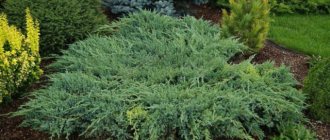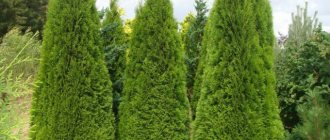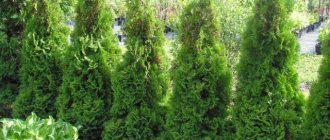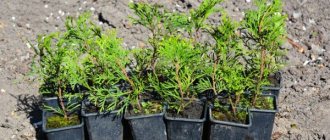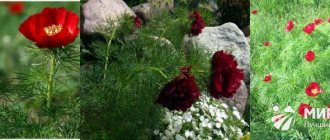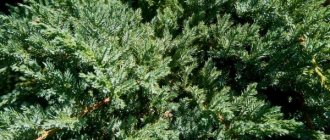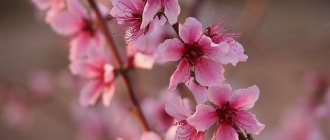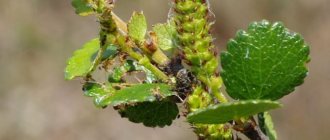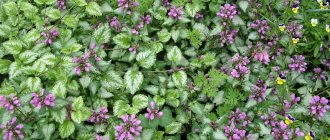Loading…
Loading…
Modern landscape design is a whole science. And even if you have never learned it, you will still be considered an expert if your garden is decorated with the magnificent thuja occidentalis Smaragd. This is an ornamental, evergreen plant, similar in appearance to cypress, completely unpretentious in care and easy to plant. Below we will tell you all the most useful and interesting things about thuja occidentalis Smaragd.
Description and characteristics of an evergreen plant
Thuja occidentalis Smaragd (description) is a monoecious evergreen plant with a dense and narrow pyramidal crown with bright green needles.
The tree is an ornamental plant, which means it belongs in a natural or artificial landscape. A hedge made of thuja Smaragd looks royal, and it’s up to you whether to make it slender and uniform or to allow each tree to grow in its own way, preserving its originality. Features and characteristics of thuja western Smaragd will help you get to know this amazing plant better:
- The height of an adult thuja Smaragd plant usually varies in the range from 4 to 6 m, and the untreated width is up to 2 meters.
- Average life expectancy is 110-130 years. If we talk about how quickly Thuja Smaragd grows, then on average, per year the tree grows no more than 20 cm in length and 4-5 cm in width.
- Thuja occidentalis Smaragd is one of the most popular representatives of the cypress family.
- The tree has the shape of an oblong cone with a pronounced crown and a thick coniferous covering. It is very malleable, which is why landscape designers love to give it different sculptural forms.
- Thuja Smaragd is an evergreen plant, which means it will remain so even in winter and after a hundred years.
- In spring, thuja blooms with small oblong brown cones, which fall off with the onset of autumn cold weather.
- Thuja feels great even in the cold Russian winters, since it has enviable frost resistance.
- The tree grows on any Russian soil and requires minimal care.
- Thuja grows not only in gardens and vegetable gardens, but also within the city. A polluted environment does not have any negative impact on the ripening of this tree.
- Thuja western Smaragd actively releases phytoncides, especially during its flowering period, due to which it purifies the air and saturates it with useful substances.
- The plant looks equally impressive in the form of a single planting and in a hedge environment.
- Thuja Smaragd occidentalis is most often divided into 2 main subspecies: thuja with a green color and thuja with a golden color.
Now you know the description of the photo of the western Smaragd thuja, and you can easily distinguish it from other species.
Description of thuja
Arborvitae are considered to be native to Asia and America, and in ancient Greece they were used for ritual processes. There are breeds whose needles contain aromatic substances. The Greeks used them to prepare incense.
Thuja belongs to the large Cypress family. The coniferous gymnosperm genus consists of 5 species, which includes about 120 species. Thujas differ in size, crown shape, and needle color.
Thuja belongs to the genus of coniferous gymnosperms, the cypress family.
Main features:
- The wild tree can grow up to 70 m in height and 6 m in diameter. Cultivated garden representatives stretch to a maximum of 20 m.
- Thuja has dense needles that resemble scales in appearance; the needles are arranged oppositely and crosswise. The predominant color in most breeds is dark or light green, but there is also golden color. After 5 years of life, the needles tend to fall off along with the branches.
- On thuja, the gender of flowers is distinguished by shape and color. Yellow-brown spikelets are considered male, while green cones with a yellowish tint are considered female. By autumn they ripen and acquire a brown color.
- Flat-shaped seeds are formed inside mature female cones.
- Each breed of thuja has its own resinous aroma.
Thujas begin to bloom in April or May, depending on the location and breed. The period is short, lasting from 6 to 12 days. The cone with seeds ripens for a long time, about 160-180 days. Abundant seed formation is observed after 2-3 years. When a mature cone bursts, they fly out, fall into the ground, and are able to germinate the next season or after 2 years.
Important! Thujas are considered long-lived, as there are breeds with a growth period of more than 150 years.
Features of proper planting
If you follow our tips and recommendations in detail, you will notice that self-planting and caring for the thuja Smaragd, the photo of which is presented below, is very simple. The most important thing you should do before boarding is:
- choose healthy, fresh seedlings;
- carefully select good cuttings;
- choose a place for the thuja (it is desirable that it grows freely).
Preparing for landing
First of all, decide how exactly you will plant thuja western Smaragd. There are 2 options here: either you purchase seedlings of a special type in plant nurseries, or you plant a tree using cuttings. The first method is the simplest, but quite expensive, but you will save a lot of time. The second option will cost you much less. For this you will need two-year-old thuja shoots. They should take root and then be ready to plant.
As for ready-made seedlings, which are usually sold in small bags, they should be carefully inspected before purchasing.
If the needles of the seedlings have a pale green appearance, then it is better to put them aside. Also note that the root system of the seedling must be fully developed and of medium size.
When choosing a place to plant thuja, consider the following points:
- A place in the open sun is not the best place for Thuja Smaragd. She may get burned due to constant lack of moisture.
- A place in the shade is also unfavorable for the plant, as it may die.
- The best place for planting is moderate partial shade. Try to choose an area protected from drafts and wind.
Tree planting process
Now that you have chosen a place for planting, good seedlings and cuttings, it’s time to start planting. You will grow a beautiful, healthy, long-lived tree if you consistently follow our advice:
- The best period for planting a tree is the end of May or the beginning of June. It is not recommended to plant trees in the fall; if early frosts hit, the seedlings may not take root and die.
- We talked about the fact that thuja takes root in any soil. But in order for the tree to grow healthy and fluffy, the soil must be prepared with a drainage system. The ideal option for drainage under thuja is drainage from a 15 cm layer of gravel or crushed brick.
- Dig a hole commensurate with the size of your seedling's root system. A depth of one meter will be quite sufficient.
- Don't forget to prepare a special mixture. To do this, thoroughly mix the following “ingredients”: turf soil, leafy soil, sand and peat (or peat deposits).
- You can accelerate the growth of thuja western Smaragd using manure or compost waste. Don't forget about mineral fertilizers too.
- Moisten the hole filled with soil thoroughly with water. Moisture is extremely necessary for a young tree.
- Plant a ready-made seedling or a created cutting in the prepared area along with a lump of earth from which they grow.
- Pay attention to the fact that the root collar of the seedling must be strictly located at ground level.
If you want to plant a hedge rather than a single plant, then make sure that the distance from one tree to another should be at least 50 cm, but no more than 1 m.
As you can see, planting thuja Smaragd is very simple. Now that you know how to plant thuja correctly. You can grow an entire hedge.
Popular varieties of western thuja
Western thuja varieties:
| Name | a brief description of |
| Thuja Brabant | This variety is characterized by rapid growth. The average height is about 5 m. Over the year the growth is approximately 40 cm. |
| Aurea Nana (thuja golden) | A characteristic feature of this variety is its bright yellow needles. It will grow up to 1.5 m in height. |
| Blue Con (thuja blue) | An adult tree is distinguished by its cone-shaped needles. In favorable growing conditions it can reach up to 2-3 m. |
| Danica | The variety was bred in 1948, but is still often used in landscape design. The shrub is spherical in shape and up to 80 cm high. |
| Columna | Characterized by a narrow crown, grows up to 3 m by 10 years. Used to create hedges. |
| Teddy | The crown grows very slowly. The needles of a young tree are soft and become prickly as they grow. |
| Martin | A tree of this variety grows up to 1.5 m. The crown is highly thickened and cone-shaped. The cones are brown and long (about 10-12 cm). |
| Mickey | A dwarf variety, the crown is cone-shaped. The needles are bright green. The plant normally survives short-term drought. |
| Sunkist | The average height of the plant is 2-4 m. In spring the crown is lemon-colored, in summer it becomes golden, and in autumn bronze. To make the color of the needles more saturated, seedlings need to be planted in the sun. |
| Hosery | The crown is of an unusual spherical shape. The needles are bright green, turning bronze in autumn. Can be planted in the shade. |
| Fastigiata | A variety of German selection. The crown is cone-shaped, the height of an adult tree is 1.2 m. The needles are dark green. |
| Little Giant | The crown is oval in shape, the shoots are very thick. The needles are green-bronze in color. Grows up to 80 cm. |
Thuja is a very beautiful and easy-to-care plant that is ideal for landscape design in both city parks and private gardens. One of the popular varieties is thuja Smaragd, but you shouldn’t stop there only. Among all the varieties there are very unusual specimens that will decorate any garden.
Features of caring for an evergreen plant
We talked about the fact that thuja requires minimal care. Even if you leave the tree to grow without your help, it will still grow and be green, but outwardly it will not look as good as it could, and its lifespan will most likely be reduced to 50-70 years.
A healthy flowering plant will delight you for many years with careful care:
- Systematic watering. Thuja occidentalis Smaragd loves moisture very much and does not tolerate soil drying out. In the summer, thuja must be irrigated with water at least once a week, and in all other seasons, 1-2 times a month will be sufficient. The tree will be grateful to you if you periodically spray it with water, thereby eliminating dust deposits and various small insects.
- Take care of the soil and soil around the plant. Remove weeds and destroy insect nests. Firstly, this will support the aesthetics of your planting, and secondly, this way you saturate the earth with oxygen, which means you contribute to the faster development of the plant;
- Do not forget to periodically loosen the soil. This is very important for providing the root system with oxygen. Please note: you need to loosen shallowly and very carefully, since you remember that you planted the thuja shallowly.
- It is important to mulch the soil once a year by adding peat and tree bark.
- Feed the plant with fertilizers 2 times a season.
- Trim your tree periodically. Careful sanitary pruning will help you get rid of dry shoots. Use only sharp pruning shears for gentle pruning.
- Cover your trees standing in the sun from the heat with a thin blanket.
Special subtleties when planting thuja
Half an hour before planting the seedling in open ground, the soil in the container must be watered with a solution of biological products. Epin, Heteroauxin, Kornevin are excellent for this purpose. If the root system is open, it is immersed in an aqueous solution of growth stimulants for half an hour, then the roots are dipped in mash.
At the bottom of the pit, lay the soil in a cone.
The seedling is placed on the top of the cone so that the root collar is 3-4 cm above the ground level. At the same time, a support for the seedling is dug into the ground. After this, the sinuses are filled with soil, compacted and watered.
Mulching is the last necessary step when planting a thuja seedling in open ground. The soil surface can be mulched with peat, pine bark, and forest cones. The litter will help retain moisture in the soil, which is very necessary for young thuja.
Pests and diseases of thuja
Thuja, as an ornamental plant, is quite often subject to insect attacks and some diseases. Here are the most common of them:
- Fungal infection. It is easily distinguishable by its brown shoots and yellow needles. Cut off affected shoots as soon as you notice them and burn them. And then, spray the entire thuja with foundationazole.
- Thuja aphid. This infection can destroy the entire tree. You can destroy aphids and cure a tree using karbofos.
- False shield. This disease is also easily recognized by the presence of growths on the needles, similar to cones. To eliminate the infection, use the drugs Rogor and Karbofos.
- Tree disease due to drying out of the soil or due to excessive watering. Both will contribute to the rapid rotting of the soil, after which the tree will inevitably die.
Perhaps these are all the diseases of Thuja Smaragd.
